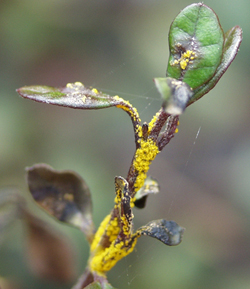About myrtle rust
The plant fungal disease myrtle rust was found in Victoria for the first time in December 2011. It was detected for the first time in Australia on the New South Wales central coast in April 2010.
It's now an established disease in Victoria, which means it can't be eradicated. The focus is now on management to:
- minimise its spread and impact
- make sure it doesn't spread to the natural environment.
There is concern that new strains may enter the country, so monitoring is in progress.
Identifying myrtle rust
To check plants for Myrtle rust, look for bright yellow egg-yolk yellow coloured spores, especially on young plant material. They first appear on the underside of leaves, then on the upper leaf surface.

See Myrtle rust host plants and symptoms or contact us for help with diagnosis.
Infected sites in Victoria
Myrtle rust has now been detected at more than 80 sites in Victoria, mainly at production nurseries and wholesale outlets and private residences in and around metropolitan Melbourne.
Detections have also been made at public parks and private residences, as well as in regional Victoria, including:
- Shepparton
- Ballarat
- Shire of Cardinia
- East Gippsland.
Most of these sites were free of the disease at the last assessment in 2014.
Myrtle rust is widespread in both New South Wales and Queensland, including some bushland areas.
Myrtle rust has not yet been detected in Victoria's natural environment.
Help managing the spread
Affected industries and agencies collaborate with us to manage the disease in Victoria, including:
- the nursery, cut flower, forestry and beekeeping industries
- the Municipal Association of Victoria
- the Royal Botanic Gardens
- Parks Victoria
- VicForests.
These agencies deal with detection on land they manage if it occurs.
Responsibility of land managers
Management of myrtle rust on both public and private land is the responsibility of the land manager. But we will continue to provide land managers (including home gardeners) with advice on how to manage infected material.
Businesses trading in Myrtaceae plants should adopt the Australian Nursery Industry Myrtle Rust Management Plan to help slow the spread of the disease.
Businesses can be penalised for selling plants that they are reasonably expected to know are infected with myrtle rust.
Moving host materials interstate
Since 30 June 2012, restrictions on importing myrtle rust host material into Victoria have no longer applied.
But other parts of Australia might have restrictions on materials exported from Victoria.